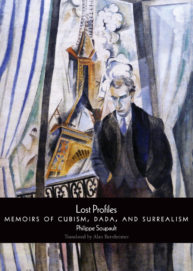 Philippe Soupault
Philippe Soupault
Translated by Alan Bernheimer
City Lights Books ($10)
by John Toren
Philippe Soupault, along with Louis Aragon and André Breton, was one of the "three musketeers" of the Surrealist movement. His brief memoir of those heady times of artistic creativity and incendiary intellectual revolt appeared in France in 1963, but it has only now been translated into English. Should we care?
Well, all such "present at the creation" memoirs carry a certain interest because the tone is anecdotal rather than scholarly, the judgments strikingly personal rather than sourly academic, and the form reflective rather than narrative or analytic. Soupault's memoir would not be out of place in the company of such minor classics as Ambroise Vollard's Recollections of a Picture Dealer, Manuel Rosenthal's Satie, Ravel, Poulenc, Jean Cocteau's Professional Secrets, or even Ernest Hemingway's A Moveable Feast.
Soupault's own poetry has been described by Paul Auster, in the introduction to the Random House Book of Twentieth Century French Poetry, as displaying a charm and humility that's often absent from Surrealist work. This memoir exhibits the same qualities. Soupault has a kind word for everyone (unlike Hemingway, for example) and tiptoes around his impressions, layering his observations in an almost Proustian fashion.
In his discussions of the origins of Dada, for example, Soupault emphasizes how he and others only gradually came to realize that the content of their manifestos was less important than the public's negative reaction to them: “The insults that were abundantly hurled at us in every tone, not to mention the rotten eggs, tomatoes, and pieces of meat, persuaded us that we were on the right path.” Yet he doesn't shrink from emphasizing that the Dadaists goal was nothing short of a moral critique of post-World War I society, and he suggests that in more recent times "the reign of the absurd" might still have an important role to play.
But Soupault's reminiscences range well beyond the movements referred to in the book's subtitle, spanning the decades from Apollinaire and Proust to Georges Bernanos and the painter Henri Rousseau. He recalls, for example, that the poet Pierre Reverdy's “gaze was as disturbing as his smile because it pinned you, like a butterfly pinned to a corkboard."
Reverdy's conversational style was similarly unusual. Soupault describes their first meeting as follows:
I made no secret of my admiration, which, though it astonished him, he judged to be sincere. But he didn’t give me a chance to talk about it. When it was his turn to speak (and he took the first turn in any conversation), he did not readily relinquish it. When I ventured to agree with him, he cut me off and said most sincerely and without any irony, “Please, let me get a word in . . . " The only thing to do was to keep quiet.
The accumulation of choice details leaves us with the impression that at an advanced age, Soupault continued to look back on the past fondly—and to inhabit, in his own quiet way, the world that had been explosively dramatized decades earlier by Dada and Surrealism, wherein events counted for more than aesthetic artifacts. Or as Blaise Cendrars had taught him, "You have to live poetry before you write it; writing, that was superfluous."
